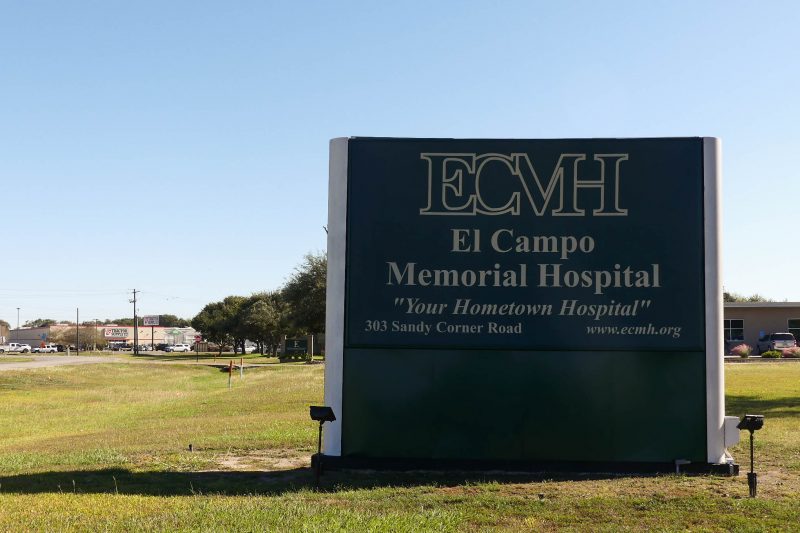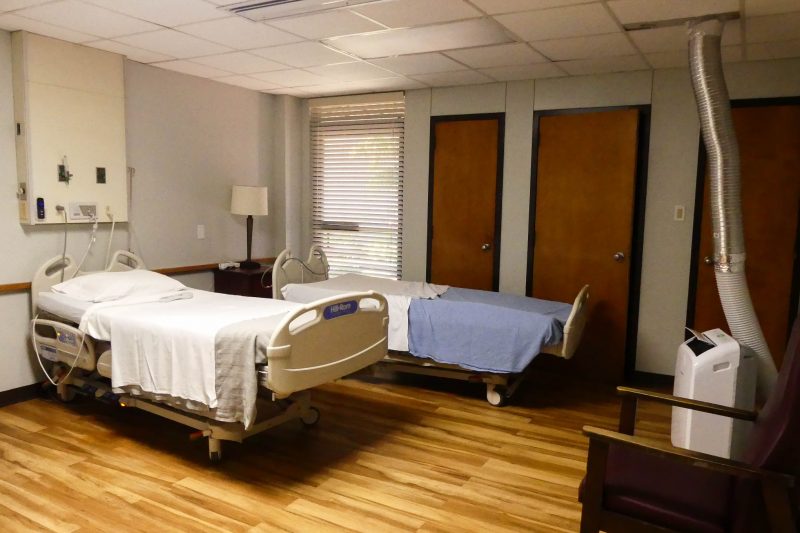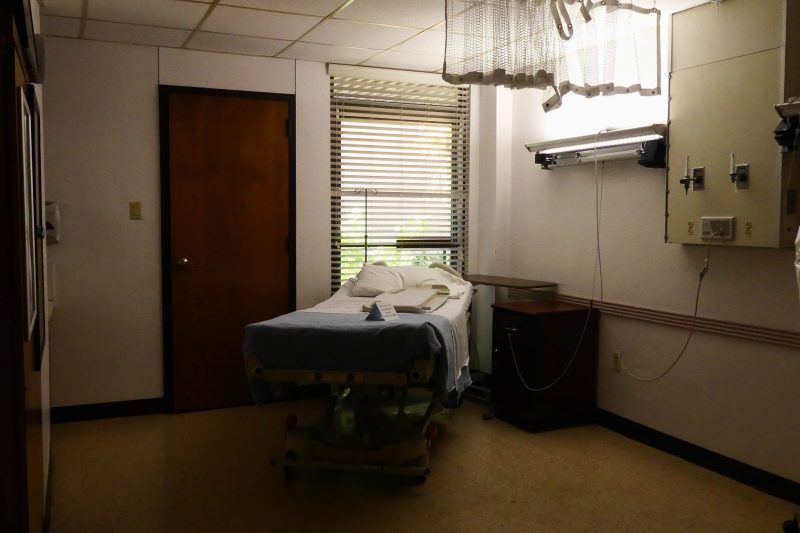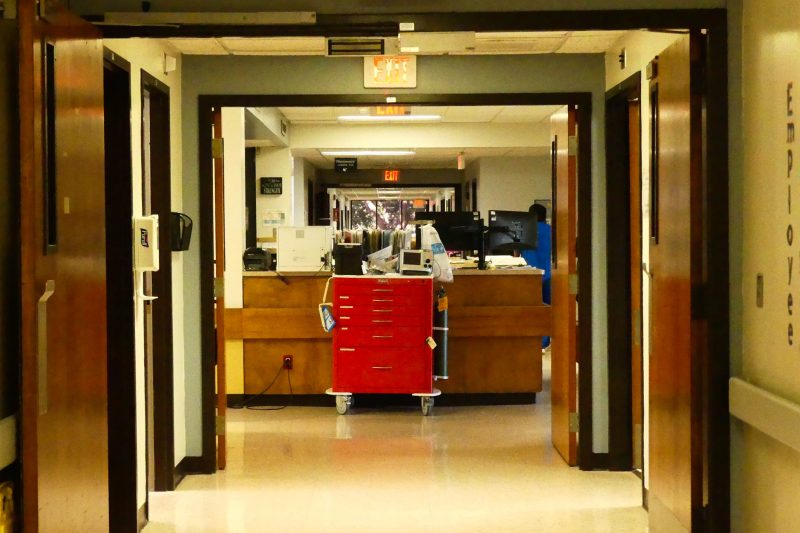On the Edge of Closure: The Daily Struggle of Rural Hospitals in Texas
By Erika González
Photography By Erika González
Reporting Texas

El Campo Memorial between Houston and Victoria is one of Texas’ rural hospitals at risk of closing. Erika González/Reporting Texas
When a patient arrives at El Campo Memorial Hospital with a heart attack, Dr. Joe Agnew knows every minute counts. In a rural hospital, where specialists are not always available, transferring someone to a fully equipped center can take more than half an hour.
“In rural medicine, you have to anticipate problems and ask yourself, ‘What if this gets worse tomorrow? Can I treat it here?’ ” Agnew said.
Agnew, 38, grew up in a small town in New Mexico and always dreamed of becoming a doctor, inspired by the idea of the physician as a pillar of the community. He arrived in El Campo more than seven years ago. Since then, he has faced the realities of rural medicine: hospitals with limited resources, few specialists and emergencies that require immediate coordination.

Dr. Joe Agnew poses with his award as one of Texas’ Top Doctors for 2025. Erika González/Reporting Texas
Like Agnew, hundreds of workers in Texas’ rural hospitals face long shifts but without any certainty that their hospital will still be there next year.
Texas leads the nation in rural hospital closures, according to the Texas Organization of Rural and Community Hospitals. In the past 20 years, 26 rural hospitals have shut their doors.
Data from the Center for Healthcare Quality and Payment Reform, a nonprofit research organization focused on improving quality and payment systems, show that 108 of the state’s 156 rural hospitals have reduced or lost critical services and that 22 face immediate risk of closure.
Each shuttered hospital represents, on average, the loss of 170 jobs and $22 million in annual payroll, hurting not only health care but also the local economy.
The search for federal funding to keep rural hospitals open
The possibility of reversing rural hospital closures is improving after Texas submitted its application for a share of $50 billion being administered by the federal Centers for Medicare and Medicaid Services to help rural hospitals. CMS is expected to announce approved funding amounts by Dec. 31. If approved, Texas could begin implementing new grants and workforce programs in rural communities as early as next year.
The new spending was included in the Big Beautiful Bill approved by Congress this summer. It was designed to offset the law’s deeper cuts to Medicaid nationwide.
“I think this is one of the biggest opportunities we have had in a generation to transform rural health,” Quang Ngo said, president of the state’s rural hospitals association. “If the state submits a strong plan and directs most of the funds to rural providers, we could see significant improvements.”

A portable air conditioning system cools one of El Campo’s emergency care rooms. Erika González/Reporting Texas
“This won’t be enough, and time is running out”
For hospitals like El Campo Memorial, these funds could mean the difference between keeping critical services running or facing closure. Still, there is uncertainty about whether the resources will arrive on time and cover all necessary costs.
El Campo Memorial Hospital, about 70 miles southwest of downtown Houston, faces a reality that mixes medical emergencies with financial pressure. Keeping a rural hospital open depends as much on the community as on available funding.
“This won’t be enough, and we are running out of time,” said Brett Kirkham, CEO of El Campo Memorial, describing the struggle to cover essential expenses in light of inadequate insurance.
“We constantly spend more than we receive. Without local taxes, we probably would have closed already,” Kirkham said.
Christal Garza, nurse and director of infection control and quality at El Campo Memorial, said that behind every medical intervention is a team and a community that support the hospital.
“We always have community members who donate and organize fundraising activities. Still, we need more support. If we had more help, we would not rely so much on these events,” she said.

This patient room at El Campo was closed for maintenance due to a lack of air conditioning during a visit in October. Erika González/Reporting Texas
The challenge of El Campo Memorial: Improvising to save lives
El Campo Memorial feels frozen in time. Built in 1979, much of its equipment still operates as it did more than 40 years ago.
“Our generator and air conditioning system are original, and replacing them costs millions,” Kirkham said.
Kirkham said some parts of the hospital become almost unbearable in summer because the air conditioning only works in certain sections. During storms or power outages, the hospital relies on generators to keep the most critical patients safe.
But physical limitations are not the only challenge. The lack of specialists is a daily struggle.
“If someone breaks their hip, we have to transfer them because there is no one to operate here,” Garza said.
The hospital staff has found ways to work around its limitations. “It was easy to say ‘we are a small hospital, we don’t do that,’” Agnew said. “But if you ask yourself ‘why can’t we do it?’ you start looking for solutions. We have managed to bring a cardiologist and a surgeon who travel here every day from other cities.”

The emergency room at El Campo Memorial stands ready for patients, stretchers, doctors and nurses. Erika González/Reporting Texas
Agnew’s days are exhausting: 12-hour shifts, coordination with three other doctors and constant pressure to anticipate situations that in large hospitals would be handled by specialists or advanced technology.
One of the biggest problems for a rural hospital like El Campo is limited perinatal care during emergencies.
“We barely handle births here, maybe one or two a year. So if someone arrives in labor, it is a challenge. We have the basics, like a baby warmer, but not everything a big hospital would have,” Garza said.
Ngo summed up the critical needs during childbirth with a phrase: They call it the “golden hour.”
“In places without maternity or trauma services, traveling more than an hour can be fatal. Some people do not even make it. Even in towns with ambulances, the round trip can take half a day. Keeping these local services is not just important, it is vital,” he said.
Patients notice the difference too. Agnew remembered that when he arrived in El Campo, many told him: “We are not used to having doctors like you here,” he said.
For him, it was not extraordinary, just his job. But seeing the real impact on the community motivated him to stay, turning every challenge into a reason to improvise and save lives.

El Campo Memorial CEO Brett Kirkham walks the halls of the hospital. Erika González/Reporting Texas
The future of El Campo Memorial Hospital if it closes
Without urgent measures, the outlook for El Campo Memorial will be bleak. Costs will keep rising, staff shortages will continue, and insurance and Medicaid reimbursements will not improve, Ngo said.
Kirkham said if the hospital stopped operating, about 75,000 people would have to travel more than half an hour for care and 350 employees would lose their jobs.
“We would have to eliminate critical units, like intensive care or certain surgeries. That would mean job losses. When a hospital closes, the whole town starts to decline. Companies do not want to invest in a place without medical services,” he said.
Despite the difficult situation, the El Campo team remains resilient.
“Many doctors could work at any big hospital and earn more, but they choose to stay. They do it because they want to help. They want to see this hospital grow,” Garza said.
“The closure of rural hospitals is dangerous,” Agnew said. “I don’t think people will fully understand it until more hospitals close.”